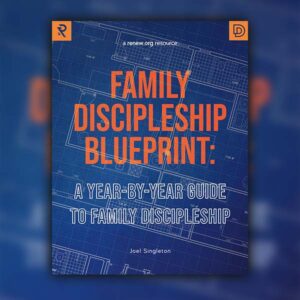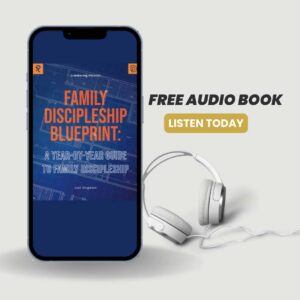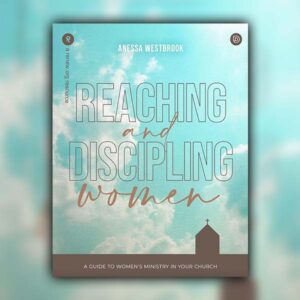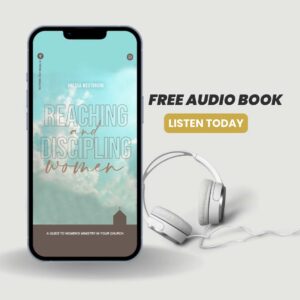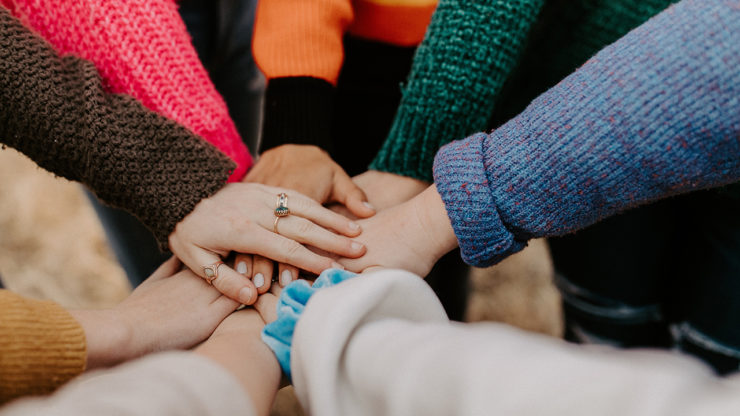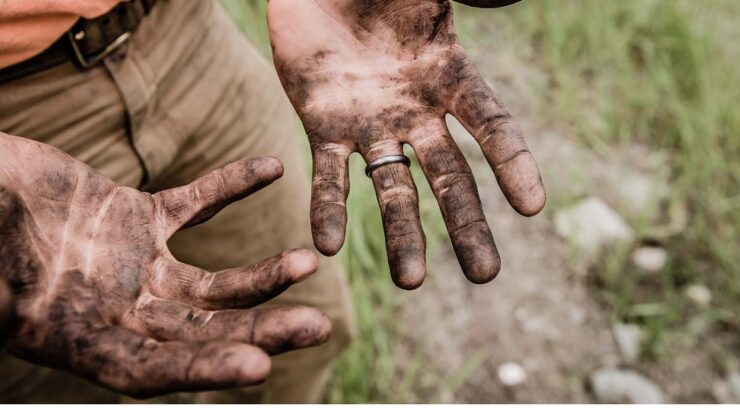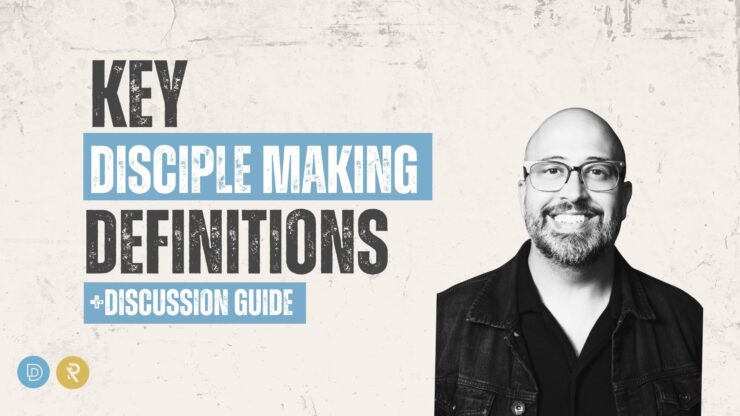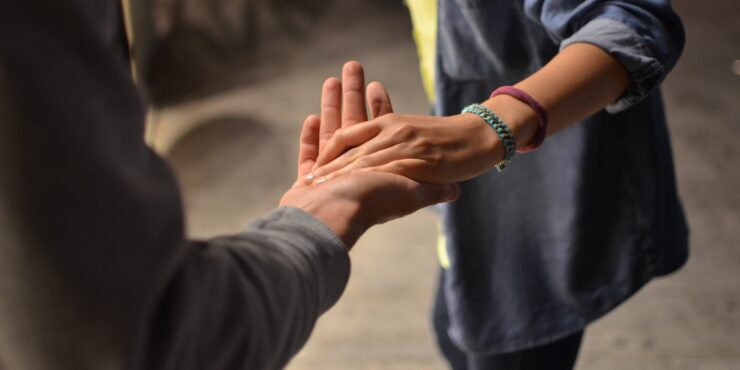Learning To Fish
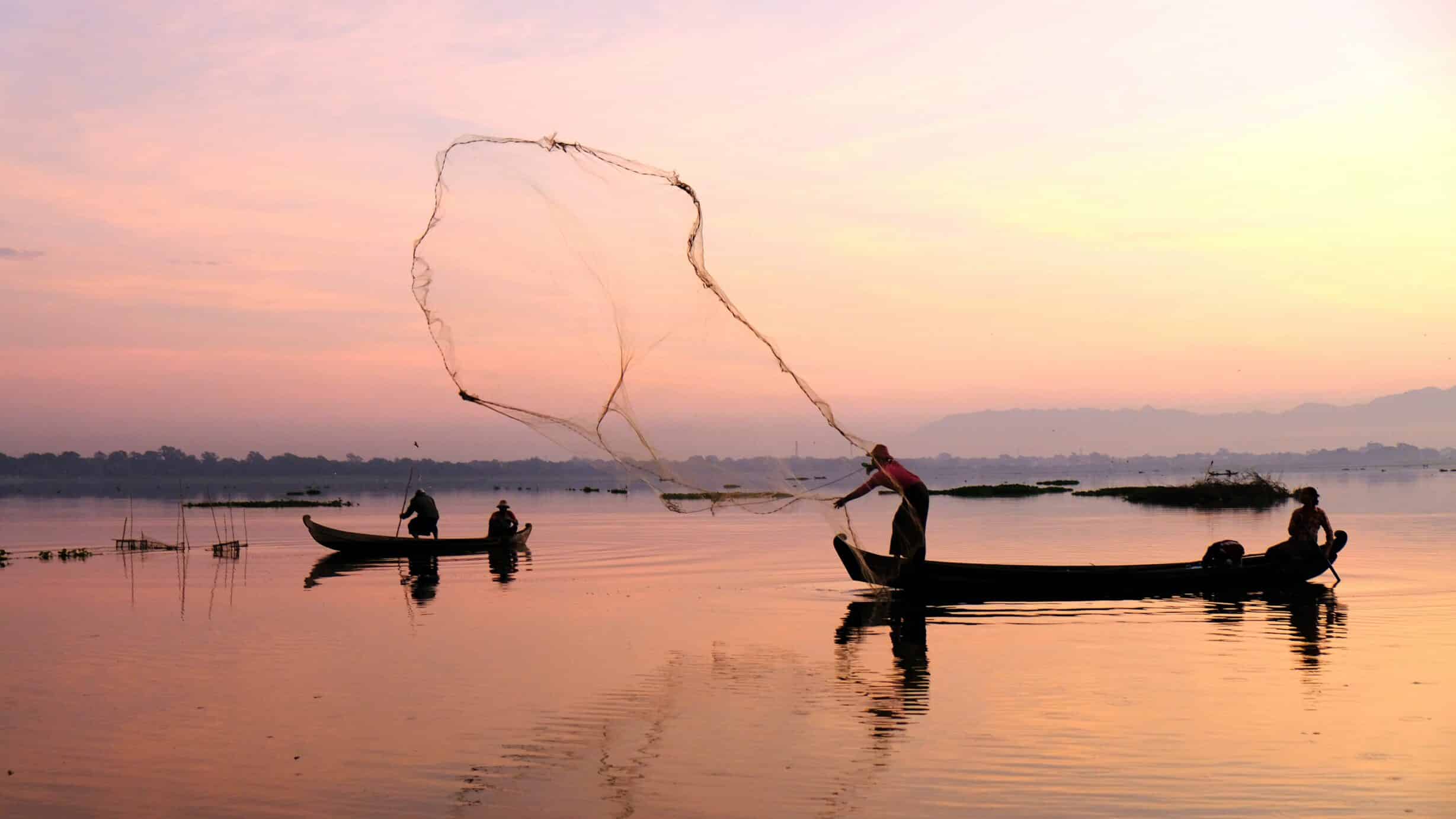
I have the privilege of volunteering as a chaplain for a police department in my area. Recently, I spent about 3 hours on a ride-along with an officer. As we drove and talked, he was sharing with me about a fishing boat that his father had given him as a gift. During our conversation, it became clear that he really enjoys fishing. Knowing that he has a daughter in middle school, I asked him if he ever taught her to fish and took her out on the boat. He explained that he taught her to fish when she was younger, and he would take her out fishing pretty regularly. But over the last few years, her interest has waned, and it’s pretty rare for her to join him anymore. Our conversation then turned to other topics, but the idea of fishing has been stuck in my head ever since.
Have you ever taught someone how to fish? For that matter, have you ever taught anyone to do anything? My guess is that most of us would answer “Yes” to that question. As you think about the process of teaching someone a new skill, habit, task, hobby, etc, what comes to mind? Do you have a specific method for teaching? Are there certain non-negotiables that must be mastered in order for someone to claim that they’ve “learned” how to do something? What’s the best way to teach something new to someone?
As Jesus moved into Phase Three of his ministry (the Ministry Training phase), he recognized that he would need to identify, engage, and equip a team of harvest workers. He modeled a Relational, Intentional, and Missional approach to this process, which he articulated in his call for a few to “Follow me (Relational), and I will show you (Intentional) how to fish for people (Missional)” (Matthew 4:19). It’s important to remember that at this point in his ministry, he had already laid a solid foundation with this small group of disciples. He used the first 18-21 months of his ministry (the Ministry Foundations phase) to begin identifying a few who were available, faithful, teachable, and responsive as he built relationships with them and modeled key foundational priorities. Only then did he invite them to a deeper level of commitment and relationship, beginning the training process with them.
PHASE FOUR / 6-9 MONTHS (CONCURRENT WITH PHASE THREE)
What’s the best way to learn how to fish? I’ve asked hundreds of people that question, and with only one or two exceptions, I always get the same answer. The best way to learn how to fish is to go fishing. Phase Four in Jesus’ ministry (the Expanded Outreach phase) is when he turned his focus to equipping his disciples to fish for people, and it happened concurrently with Phase Three. Jesus knew that the best way to teach and equip his disciples to fish for people was to take them fishing. This 6-9 month time period in Jesus’ ministry involved both ministry training and expanded outreach. He taught his disciples how to fish for people by taking them with him on “fishing expeditions” — these expeditions provided the opportunity and environment for valuable learning and unforgettable growth for his ministry team.
Here are the 6 Fishing Expeditions:
- Jesus heals a demon possessed man in the synagogue
- Jesus heals Peter’s mother-in-law and many others
- Jesus gives a second call to fish for people
- Jesus cleanses a leper
- Jesus heals the paralytic and forgives his sins
- Jesus calls Matthew and dines with his friends
WHERE, HOW, & FOR WHOM DID JESUS FISH?
The gospel writers identify 6 specific Fishing Expeditions that Jesus used as he began to train his ministry team to fish for people. Each of these Fishing Expeditions is a great example of the concept of Peer Share — engaging the lost in spiritual conversation and calling them to “Come and see” who Jesus is. Now, these aren’t the only fishing expeditions in Jesus’ life and ministry, but they are the framework for Jesus’ method of equipping in Phase Four. In each of these expeditions, it’s important to notice where Jesus went fishing, how he was fishing, and for whom he was fishing.
Jesus’ fishing method had an “arc” that I find fascinating. In order to see this arc, you have to step into the sandals of Jesus’ disciples and look at these experiences through their eyes. As you work your way through these Fishing Expeditions from the perspective of Jesus’ disciples, you’ll notice that the location where Jesus is fishing as well as the people for whom Jesus is fishing gradually move from comfortable to uncomfortable. For instance, note the difference between the synagogue (very comfortable) and the home of a tax collector (very uncomfortable). During these Fishing Expeditions, Jesus modeled how to fish for different types of people who were spiritually lost (religious, friends, family, outcasts, leaders in the community, notorious sinners, etc). His disciples had varying degrees of comfort with each of these groups of people, and Jesus masterfully moves from the comfortable to the uncomfortable. As he gradually pushed his disciples further out of their comfort zones, their faith was deepened, their understanding grew, and their dependence (and awareness of their need to depend) was developed.
It may go without saying (although probably not), but Jesus wasn’t only fishing for lost people during Phase Three/Four. He was also fishing for believers — his own disciples, who were not only in the process of learning to fish for people themselves, but also still growing in the area of following their rabbi (remember how Jesus began his call in Matthew 4:19 — “Follow me…”). This type of fishing could be categorized as Peer Care — encouraging believers and inviting them to “Follow me (Jesus)” as they grow and mature. Jesus’ disciples needed to regularly be reminded of their need to continue to follow him (in fact, he would later tell them specifically that apart from him, they could do nothing). The importance of this can’t be overstated — throughout Jesus’ ministry, in the midst of serving, reaching, loving and serving all sorts of people, his focus remained on making disciples who could make disciples. It’s the thread that runs through his whole ministry. No matter where he went or what he did, he always had his disciples in mind, and he was always concerned with their development.
FISHING LIKE JESUS
How do we equip students to fish for people in their natural path of life? If the best way to learn to fish is to go fishing, then we take them fishing! Since Jesus is our model, we can follow his example and take our students out fishing just like he did, and we should go fishing in the same types of places that Jesus took his disciples:
- Mark 1:21 // Synagogue = our local church (believe it or not, there are religious lost people there!)
- Luke 4:38 // Peter’s house = a student’s home
- Luke 5:1 // Marketplace (Peter’s place of business) = your students’ school
- Luke 5:12 // One of the cities = out in your community
- Mark 2.1 // At home = your house!
- Matthew 9:10 // The home of another disciple = another student’s home
In between each of these Fishing Expeditions, there was time for debrief, discussion, Q&A, and teaching. As we develop programs in our student ministry context, we have to not only plan out specific opportunities for students to go fishing — we also need to leave space for these kinds of interactions between fishing trips.
Developing a Student Ministry Team provides a place within our ministry for all of this, calling students to a deeper level of relational engagement combined with equipping for Peer Share/Peer Care. We can spend focused time with this group of students, just like Jesus spent with his disciples, training them to fish for people and giving them experiences and opportunities to watch us model how to fish as well as to practice fishing themselves.
We should also carefully plan events and programs to model fishing and equip students to fish for people. Sonlife is committed to challenging and equipping youth ministries to implement Jesus’ disciple-making strategy, so we’ve developed events, training opportunities and programs that are designed for the specific purpose of equipping students to fish for people.
We’re partnering with Moody Bible Institute to put on XJ: Experience Jesus in Chicago next summer. XJ is an equipping event specifically designed to prepare high school students to live out their faith, defend their faith, and share their faith with their friends.
Sonlife’s Fusion short-term missions experience partners student ministries from North America with student ministries from Latin America to develop healthy, disciple-making student ministries and begin disciple-making movements globally. Fusion is designed to equip students for cross-cultural Peer Share and Peer Care. We’ve seen thousands of students learn how to make disciples while deepening their faith and learning dependence on the Father. Brad is one of these students. He was a junior in high school and an active part of our student ministry when I was a youth pastor. Each year, I took students on Fusion trips to Costa Rica, and I was always struck by how much students grew as a direct result of being pushed out of their comfort zones.
Brad is a great example — before Fusion, he’d never been out of the country, and was never really exposed to different cultures. He grew up in the suburbs, and was very insulated from the rest of the world. It only took 11 days in Costa Rica to ignite a passion in Brad’s heart for the world, and he’s been serving with various international ministries for the past 15 years. As a youth pastor, Fusion was a great tool that I could use to challenge students to step out of their comfort zones, just like Jesus challenged his disciples.
Whatever specific programs, events, tools and resources we use, we absolutely have to stay focused on Jesus’ model in Phase Four of equipping his disciples to fish for people by taking them to various environments and giving them various experiences. It’s vital that we make intentional decisions about where we go, how we fish, and for whom we fish.
This post originally appeared at: Learning To Fish – Sonlife
Because of the importance of intentionality in disciple making, we at Discipleship.org are going to emphasize this skill set and mindset over the next four months. Please join with us and seek to share understanding, insight, and practical tools so that you can become skilled at intentionality in relational disciple making and you can help those on your team or in your leadership group to do the same. There are four ways in which we are emphasizing intentionality to help you in the next four months.
- Discipleship.org City Tour Forums – our four City Tour Forums are designed to help you and your team both understand and develop an intentionality posture. The tour is comprised of one day, high impact forums where there will be teaching and round table discussions. Every attendee also gets a copy of Brandon Guindon’s new book, Intentional: Living Out the Eight Principles of Disciple Making.
Click the image below for more information.
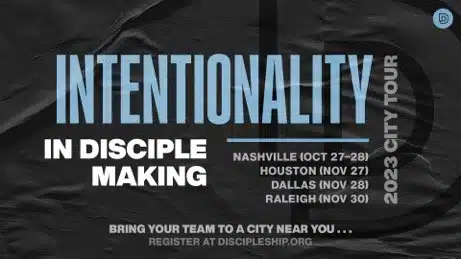
Take the FREE Individual Disciple Maker Assessment – we designed this assessment with a team of national and international disciple making leaders to help each individual be able to evaluate their disciple making mindset and skill. Just by taking this assessment, you will gain an appreciation for the value of intentionality, along with a sense of how you can increase your own level of intentionality. Click the image below to take the assessment.

- Read the short FREE book, Becoming a Disciple Maker: The Pursuit of Level Five Disciple Making – Bobby wrote this short eBook with statistician Greg Wiens to help you understand the mathematical and practical impact of one person’s disciple making efforts and skills.
Click the image below to download this free eBook.
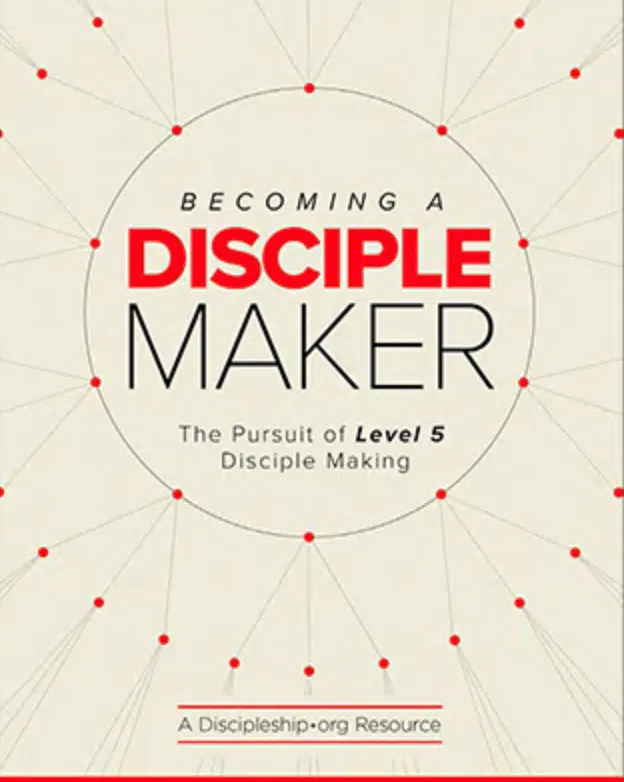
- Read Brandon Guindon’s book, Intentional: Living Out the Eight Principles of Disciple Making – Brandon wrote this Discipleship.org book and Zondervan is publishing, because the understanding and practice of disciple making is so crucial. Every attendee at each of our City Tour events (Nashville, Houston, Dallas and Raleigh), as mentioned above, will receive a FREE copy of Brandon Guindon’s book.
Click the image below to order Brandon Guindon’s book from Amazon.com.
Please join with us in this quest to better understand and practice intentionality. It will help us all to become more and more like Jesus, the world greatest disciple maker.
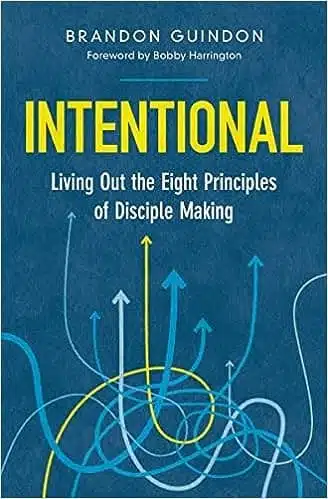
If you have enjoyed reading this, please consider joining our email list!


